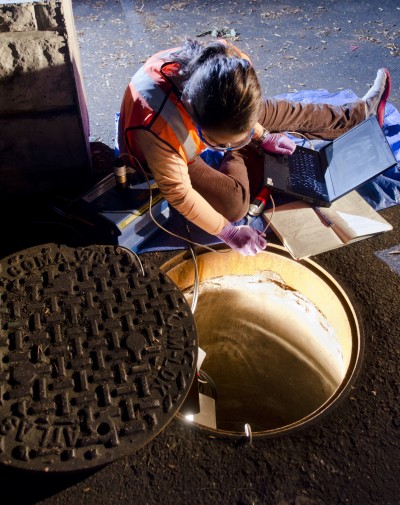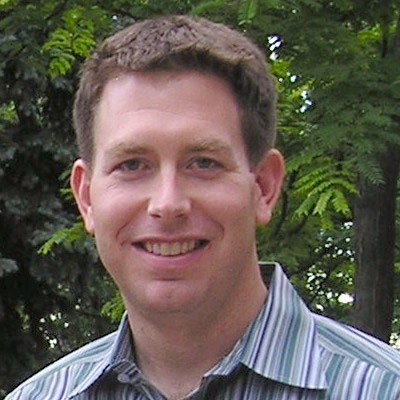Puget Sound scientist to study how Washington State’s legal marijuana stores affect personal use
TACOMA, Wash. – Several American states have now legalized recreational marijuana, including Washington, which approved adult use in fall 2012. Yet just how this will affect people’s use of the drug remains uncertain.
Dan Burgard, associate professor of chemistry at the University of Puget Sound, is gathering scientific evidence to answer that question, using a pioneering research technique and more than $120,000 in support from the National Institute on Drug Abuse at the National Institutes of Health. His three-year research project, which builds on four years of previous work, began in Washington state this month.
Burgard and student assistants test the public wastewater at two Western Washington sewage treatment plants for traces of marijuana, using a retrieval and chemical analysis method that Burgard adapted from earlier work by scientists in Italy. Burgard says the research will provide objective evidence that has not been available before.
“In the past, authorities have tended to rely on consumer surveys to determine trends in cannabis use,” Burgard said. “However such surveys are notoriously biased because they depend on respondents being honest about a sensitive drug usage issue. A chemical analysis that is testing water at the rate of ‘parts per trillion’ has no reason to lie.”
The research is being done in collaboration with the University of Washington’s Caleb Banta-Green, a senior scientist at the Alcohol and Drug Abuse Institute. It has the potential to provide health and civic authorities across the country with valuable information about:
- Whether (and how much) marijuana use went up, per capita, after legalization in a population center in Western Washington.
- Whether the opening of new, legal stores correlated to a change in community cannabis use, as well as estimating the market share of the drug’s legal recreational use, compared to that of medicinal and black-market drug use
- Any trends on different days of the week
- How the total consumption of legal recreational marijuana changes between 2013 and 2017 (i.e., whether there will be a “honeymoon” period of popularity and then consumption will drop off)
- How the research results correlate with national surveys on marijuana, allowing authorities to confirm national estimates of total population cannabis use (currently estimated at 17 million people who used marijuana “in the prior month”)
“If people who used marijuana in the past are simply switching their supply source from the black market to legally authorized and quality-controlled store-sold marijuana, then that should be good news for health officials,” Burgard said. “However, if this research indicates a surge in people’s use, particularly during the working week, that could be a considerable concern.”
Burgard and his student assistants started collecting data from the two treatment plants, with city officials' cooperation, in December 2013, before the July 2014 opening of the first legal recreational marijuana stores in Washington state. Using scientific methods that control variables, they will now measure THC metabolites' levels (an active component of marijuana) in the same wastewater plants over the next three years. These measurements will be compared with the pre-store levels.
The research also will compare the legal sales documented by the state Liquor Control Board with the total measured cannabis levels in wastewater. The researchers will try to assess the changes in market share between legal, illegal, and medical marijuana.
Officials from Washington state’s Department of Health and Liquor Control Board, from the Colorado Division of Criminal Justice and Department of Public Safety, and nearby cities have shown support and expressed interest in seeing the results. The media has also covered Burgard’s earlier work, with news features on the Discovery Channel and KOMO television, and stories in local, national, and international media.
The idea of testing wastewater for drugs was first introduced in Italy in 2005. Burgard created his own device for taking water samples from underground sewers and then ran the samples through a high-performance liquid chromatography and mass spectrometry instrument in collaboration with researchers from the University of Washington, Tacoma Center for Urban Waters. Puget Sound science professors currently have a request with the National Science Foundation for a similar high-performance instrument, which Burgard says would greatly enhance his research and professors in biology, chemistry, and neuroscience.
It will take three full years—including the testing of 110 random, one-liter samples per year—for Burgard to have insight into his questions. However, he plans to present some preliminary findings at an international chemistry conference in Switzerland this October. Currently, Washington, Colorado, Alaska, Oregon, and the District of Columbia have legalized the adult use of recreational marijuana.
Press photos of Dan Burgard and students extracting water samples from sewage systems are available upon request.
Photos on page: Top right and left: Chemistry student Kathryn Ginsberg '14 collects wastewater to be tested for traces of pharmaceutical drugs from a sewer. The work was a precursor to research by Professor Dan Burgard and chemistry students testing wastewater for marijuana. Above left: Dan Burgard.
Tweet this: #Marijuana research @univpugetsound will test the effect of WA legalization. Prof Dan Burgard wins @NIH grant for work. #highered http://bit.ly/1CpxDfL
Follow us on Twitter! twitter.com/univpugetsound




